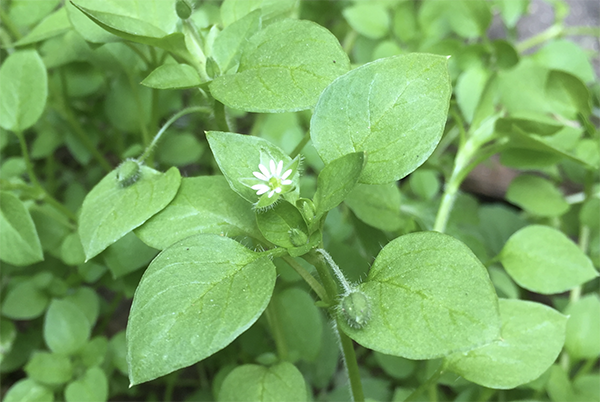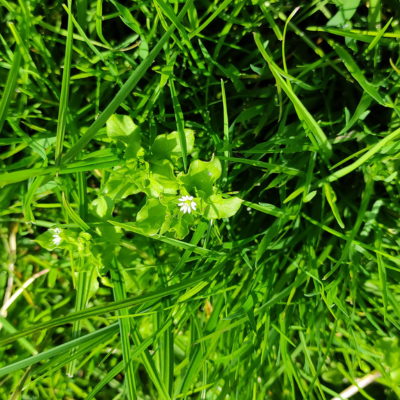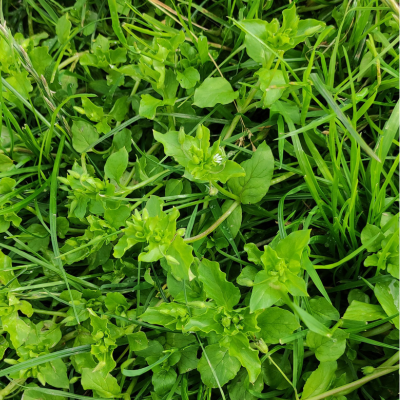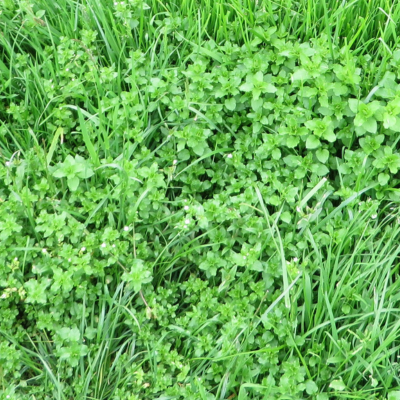Chickweed's fast growth can smother grass, resulting in reduced grass cover and bare patches when the chickweed dies off.
Chickweed

What is common chickweed?
Common chickweed is a low-lying annual plant and can be found in newly sown leys and established grassland. It is important to control common chickweed as its fast growth can smother grass, resulting in reduced grass cover and bare patches when the chickweed dies off. This leaves open soil for other weeds to then colonise.

Biology
Chickweed will grow where the ground has been cultivated or where other weeds have been removed, leaving bare patches for its establishment.
Plants can reproduce by seed moved by birds, or vegetatively by root cuttings.
It spreads by seed, which can remain viable for more than 5 years.
Each chickweed plant can produce up to 2,500 seeds.
How can I identify common chickweed?
Plants have round, hairy stems that branch extensively whilst remaining low to the ground.
Leaves are oval and green and end in a slight point.
Plants flower from June to August with white flowers.
The white flowers are small, and star shaped.
It is a low ground hugging weed with shallow roots and the weed is an annual weed, only living for one year.
It can germinate and set seeds throughout the year making it seem like a perennial weed.
 Flowering chickweed
Flowering chickweed
 Closer look at the leaves
Closer look at the leaves
 Patch of chickweed
Patch of chickweed
Why is chickweed a problem?
Chickweed competes aggressively with grass due its rapid prostrate growth, therefore reducing grass yield and grass quality.
Chickweed can grow at relatively low temperatures and may suppress overwintered crops or, if dense, severely restrict crop growth.
Germination of chickweed can occur throughout the year, with up to three generations possible in any one year, and plants may be seen to be flowering at any time.
Spring-germinating plants die in late summer, while autumn-germinating plants survive the winter as a dense, low-growing mat.
Chickweed is a particular problem in newly sown leys, as it establishes and grows quickly after sowing and can outcompete grass.
How do I control chickweed?
In newly sown leys, it is important to control plants at the seedling stage by applying herbicide before first grazing. To effectively manage chickweed, try and establish the grass sward rapidly.
If new grass leys are sown late and poorly established, then there is high chance that chickweed could dominate.
Cultural solutions include grazing or topping the weed, provided that the grass is not too high or dense.
Product Choice
Envy is the best herbicide treatment for long-term control of chickweed in both newly sown leys and established grassland. It can be used in cooler conditions in the early spring at a time when chickweed will begin to grow rapidly and smother the crop.
It does not carry any grazing, cutting or manure restrictions.
Dense patches of weed may need a follow up treatment.
Large bare patches left after killing the chickweed should be over-seeded to avoid colonisation of the bare patch by more weeds.

Envy® is the best option for controlling chickweed (common and mouse-ear) in cooler conditions and also controls a wider spectrum of weeds than straight fluroxypyr.